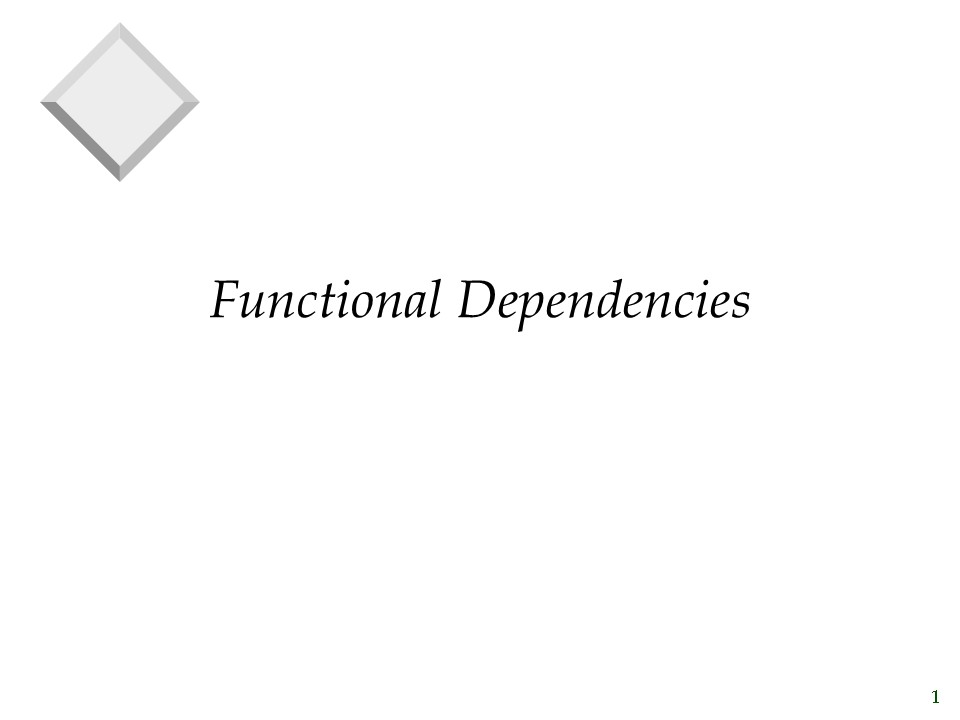Functional Dependencies PowerPoint PPT Presentation
1 / 10
Title: Functional Dependencies
1
Functional Dependencies
2
Motivation
- E/R ? Relational translation problems
- Often discover more detailed constraints after
translation (upcoming example) - Some relationships not easily captured in E/R
diagrams for a particular star and movie, there
is exactly one studio - Sometimes attributes were misplaced in an E/R
diagram (Section 15.3.3)
Contracts
Star
Film
Studio
3
The Evils of Redundancy
- Redundancy is at the root of these problems
- redundant storage, insert/delete/update anomalies
- Integrity constraints, in particular functional
dependencies, can be used to identify schemas
with such problems and to suggest refinements. - Main refinement technique decomposition
(replacing ABCD with, say, AB and BCD, or ACD and
ABD). - Decomposition should be used judiciously
- Is there a reason to decompose a relation?
- What problems (if any) does the decomposition
cause?
4
Functional Dependencies (FDs)
- A functional dependency X Y holds over
relation R if, for every allowable instance r of
R - (t1 r, t2 r, t1.X t2.X) implies t1.Y
t2.Y - i.e., given two tuples in r, if the X values
agree, then the Y values must also agree. (X and
Y are sets of attributes.) - An FD is a statement about all allowable
relations. - Identified by DBA based on semantics of
application. - Given some allowable instance r1 of R, we can
check if it violates some FD f, but we cannot
tell if f holds over R! - K is a candidate key for R means that K R
- K R means that K is a superkey
5
Example Constraints on Entity Set
- Consider the relation schema for Hourly_Emps
- Hourly_Emps (ssn, name, lot, rating, hrly_wages,
hrs_worked) - Notation We will denote this relation schema by
listing the attributes SNLRWH - This is really the set of attributes
S,N,L,R,W,H. - Sometimes, we will refer to all attributes of a
relation by using the relation name (e.g.,
Hourly_Emps for SNLRWH). - Some FDs on Hourly_Emps
- ssn is a candidate key S SNLRWH
- rating determines hrly_wages R W
6
Example (Contd.)
- Problems due to R W
- Update anomaly Can we change W in
just the 1st tuple of SNLRWH? - Insertion anomaly What if we want to record the
fact that rating 6 implies wages 10? - Deletion anomaly If we delete all employees with
rating 5, we lose the information about the wage
for rating 5!
Hourly_Emps2
Wages
7
Reasoning About FDs
- Given some FDs, we can usually infer additional
FDs - S R, R W implies S W
- An FD f is implied by a set of FDs F if f holds
whenever all FDs in F hold. - closure of F is the set of all FDs that
are implied by F. - Armstrongs Axioms (X, Y, Z are sets of
attributes) - Reflexivity If Y X, then X Y
- Augmentation If X Y, then XZ
YZ for any Z - Transitivity If X Y and Y Z,
then X Z - These are sound and complete inference rules for
FDs!
8
Reasoning About FDs (Contd.)
- Couple of additional rules (that follow from AA)
- Union If X Y and X Z, then X
YZ - Decomposition If X YZ, then X
Y and X Z - Example Contracts(cid,sid,jid,did,pid,qty,valu
e), and - C is the key C CSJDPQV
- Project purchases each part using single
contract JP C - Dept purchases at most one part from a supplier
SD P - JP C, C CSJDPQV imply JP
CSJDPQV - SD P implies SDJ JP
- SDJ JP, JP CSJDPQV imply SDJ
CSJDPQV
9
Reasoning About FDs (Contd.)
- Computing the closure of a set of FDs can be
expensive. (Size of closure is exponential in
attrs!) - Often, we just want to check if a given FD X
Y is in the closure of a set of FDs F. An
efficient check - Compute attribute closure of X (denoted )
wrt F - Set of all attributes A such that X A is in
- There is a linear time algorithm to compute this.
- Check if Y is in
- Does F A B, B C, C D E
imply A E? - i.e, is A E in the closure ?
Equivalently, is E in ?
10
Summary
- E/R ? Relational translation can lead to
relational schemas with redundancy (wasted space,
anomalies) - Functional dependencies
- Describe connections among attributes
- Allow us to precisely describe the redundancy
- Allow us to eliminate it algorithmically by
decomposing the relation with the redundancy
(more next time) - We can use given FDs to derive others (closure of
a set of dependencies) - We can determine candidate keys (attribute
closure)

